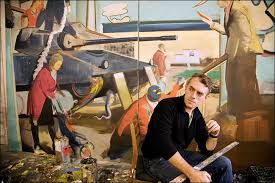 Near the end of the late Gothic period, the oldest art centers of Germany and the Netherlands, went into decline. Cities such as Antwerp and Nuremberg, very quickly took over the lead role in the development and diffusion of the Renaissance style - not only in painting but also in other art forms. The main support for these events came from a wide network of humanist circles. Albrecht Dürer, who brought the new style of Nuremberg after his visits to Venice (1494-95 and 1505-07), became the founder of Renaissance southern Germany. The composition of the figures in his paintings shows a precise observation of the anatomy, understanding of perspective and a new vibrant use of color. His study of antiquity and Italian Renaissance was the basis of their new images.
Near the end of the late Gothic period, the oldest art centers of Germany and the Netherlands, went into decline. Cities such as Antwerp and Nuremberg, very quickly took over the lead role in the development and diffusion of the Renaissance style - not only in painting but also in other art forms. The main support for these events came from a wide network of humanist circles. Albrecht Dürer, who brought the new style of Nuremberg after his visits to Venice (1494-95 and 1505-07), became the founder of Renaissance southern Germany. The composition of the figures in his paintings shows a precise observation of the anatomy, understanding of perspective and a new vibrant use of color. His study of antiquity and Italian Renaissance was the basis of their new images.Lucas Cranach the Elder was influenced by Dürer early in his career, but after 1505, developed his own very personal style in a work particularly extensive. As court painter to the dukes of Saxony in Wittenberg was forced to produce pictures, but also was responsible for the decoration of churches. Which had links with the humanist thinkers and was a friend of Martin Luther, who is often portrayed. Apart from the religious paintings (for example, The Martyrdom of Saint Catherine) Cranach was particularly interested in the representation of secular and mythological subjects (such as Venus and Cupid, Apollo and Diana, and the Trial of Paris), and these works show clearly Cranach the importance of art of Renaissance concept of beauty that emerged from the rediscovery of antiquity.
Hans Old Burgkmair first studied in the Upper Rhine region, with Martin Schongauer, and then settled in Augsburg in 1498. In 1503 he visited Cologne where Stefan Lochner Doomsday copied in a drawing. He also visited Italy and Venice, where he learned the principles of the new style. As a painter of both altarpieces and portraits, he is an artist in transition. Burgkmair made connections at court and produced a series of woodcuts for Emperor Maximilian I, became famous as an outstanding portrait painter in the new style between 1490 and 1512.
The influential role of Italian art can also be seen in the work of Georg Pencz. Headquartered in Nuremberg, which became the painter of the city in 1532, was a follower of Dürer and is likely to have formed in his workshop. Some of his panels show a close similarity to the style of Durer and often passed through Dürer's work.
Tags: Art, Painting
0 comments:
Post a Comment